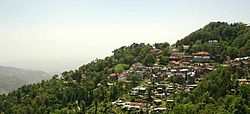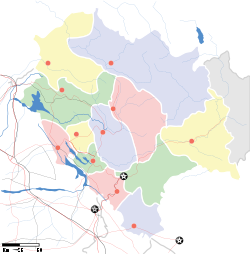- Dalhousie, India
-
Dalhousie — town — Coordinates 32°32′N 75°59′E / 32.53°N 75.98°ECoordinates: 32°32′N 75°59′E / 32.53°N 75.98°E Country India State Himachal Pradesh District(s) Chamba Population 7,419 (2001[update]) Time zone IST (UTC+05:30) Area
• 1,954 metres (6,411 ft)
Dalhousie (Hindi: डलहौज़ी) is a hill station and popular tourist spot in the northern state of Himachal Pradesh, India.
Contents
Weather
Dalhousie experiences winter-like cold climate throughout the year. Heavy rain with thunder showers are experienced during the period from June to September. In May–July it is usually warm in the morning and afternoon but gets cold early in the evening and quite cold at night. The weather becomes very cold during winter and if it rains. Dalhousie also experiences snow during the peak of winter period in December and January. Being a hill station, Dalhousie is famous for its salubrious climate.
Etymology
The Dalhousie Town was named after Lord Dalhousie who was the British Governor-General in India while establishing this place as a summer retreat.
Points of interest
Dalhousie has many places to visit. A favorite spot for tourists is the area near Alla. It is a potato field and it offers mesmerizing scenic landscape. Another popular spot is the area of Karelanu. It is famous for its precious water which healed a great leader, Subhash Chandra Bose. He was suffering from tuberculosis and he regularly drank the water from the natural spring in Karelanu and was healed.[citation needed]
History
Dalhousie is a hill station in Himachal Pradesh. Established in 1854 by the British Empire in India as a summer retreat for its troops and bureaucrats.
It is built on and around five hills. Located on the western edge of the Dhauladhar mountain range of the Himalayas, it is surrounded by snow-capped peaks. Dalhousie is situated between 6,000 and 9,000 feet (2,700 m) above sea level. The best time to visit is in the summer, and the peak tourist season is from May to September. Scottish and Victorian architecture is prevalent in the bungalows and churches in the town.
Dalhousie is a gateway to the ancient Chamba Hill State, now Chamba District of the state of himachal pradesh of India. This hill region is a repository of ancient Hindu culture, art, temples, and handicrafts preserved under the longest-running single dynasty since the mid-6th century. Chamba is the hub of this culture. Bharmour, the ancient capital of this kingdom, is home to the Gaddi and Gujjar tribes and has 84 ancient temples dating from the 7th–10th century AD.
Timeline
- 1849 Punjab was annexed to the British Raj after the Second Anglo-Sikh War.
- 1850 Lt. Col. Napier, Chief Engineer of Punjab was enchanted by the scenic spot in the Chamba state and visualized the project.
- 1851 Selection of the site was finalized. A spot where the Dainkund Ridge, at the western edge of the Dhauladhar range of the Himalayas, breaks into spurs was carved out. Dr. Clemenger of the 49th Native Infantry was in charge of the site development.
- 1853 Thirteen square miles of land comprising the five hills Kathalagli, Potrein, Terah (Moti Tibba), Bakrota, and Bhangora were acquired by the Government of India from the Raja of the Chamba state. In return, the annual tribute that the Chamba state paid to the British Government was reduced by 2000 rupees. The total tribute at that time was 12,000 rupees per year.
- 1854 Sir Donald McLeod recommended that the estate be named after Lord Dalhousie, the viceroy of India at that time. Convalescent Depot was constructed at Kathalag. It was made part of the Kangra District in the Punjab state.
- 1860 Three level malls around Bakrota, Terah, and Potrein hills were laid down. The roads that connect these malls are still the main arteries of the city today.
- 1863 St. John's church was built at the G.P.O. (Now known as Gandhi Chowk) Reverend John H. Pratt was instrumental in raising money from the Christian community.
- 1873 Rabindranath Tagore spends time in Dalhousie.
- 1884 Rudyard Kipling visited Dalhousie.
- 1894 The St. Francis Church was built at Charing Cross (now known as Subash Chowk)
- 1903 St. Andrew's Church (AKA The Church of Scotland) was built at Dalhousie Cantt.
- 1909 St. Patrick's Church was built near the military hospital at Dalhousie Cantt.
- 1910 Convent of the Sacred Heart, a residential school for girls, was started under the Archdiocese of Lahore.
- 1915 Sadar Bazar, the main market of Dalhousie, was burnt down by a ferocious fire. The new Sadar Bazar buildings came up, and stone was used instead of wood. These 3-4 storey stone houses with slop?
- 1920 Electricity was first distributed. A large generator using diesel was built to bring the electricity to the elite town.
- 1920s-1947 Dalhousie was at its peak as a tourist destination.
- 1954 Pt. Nehru, then prime minister of India, presided over the centennial celebrations of Dalhousie. He initiated promotion of tourism with the call Let us go to the Himalayas.
- 1959 Tibet was taken over by China. Dalhousie was picked to host several thousand Tibetan refugees at the insistence of Pt. Nehru. Most of them have left the town. However, they have left their influence in the form of road-side rock sculptures and a Tibetan market near the GPO.
- 1962 Dalai Lama visited Dalhousie. He visited again in 1988.
- 1966 During Reorganisation of States, Dalhousie was transferred to the Himachal Pradesh from Punjab.
- 1990s Dalhousie becomes a favorite shooting spot of Bollywood. Many Hindi films, including 1942: A Love Story, were filmed here.
Economy and industry
Dalhousie being one of the beautiful tourist spots, plays an important role in the economy of the state. The major industry is tourism. Dalhousie has a huge number of hotels to accommodate the tourists. Dalhousie also offers several non-hotel stays like independent villas and bungalows which offer an alternative to typical hotels. There are just over 600 hotels, which provide temporary jobs to about 5,000 to 8,000 people every year. This town alone counts for almost 3% of GDP of its state.[1]
Major attractions
- Dainkund Peak
- Khajjiar
- Bakrota Hills
- Village Lohali
Eight road junction
At Gandhi Chowk in Dalhousie is a Road junction of eight roads.[2] These roads lead to:
- 1) Subhash Chowk
- 2) Panchpula
- 3) Upper Bakrota
- 4) Diankund
- 5) Banikhet via Busstand
- 6) Khajjiar
- 7) Sadar Bazar
- 8) Motitibba
Important areas
- Gandhi Chowk
- Diankund
- Bakrota Hills
- Dalhousie Cantonment
- Sadar Bazar
- Tibetan Market
- Panchpula [3]
Gallery
References
External links
Himachal Pradesh topics Major cities Districts Culture Economy Jurisdiction Geography History Education Indian Institute of Technology Mandi · Dr. Yashwant Singh Parmar University of Horticulture and Forestry · Green Hills Engineering College · Himachal University · IITT college of Engineering · Indian Institute of Advanced Study · Institute of Engineering and Emerging Technologies · National Institute of Technology, Hamirpur · Jaypee University of Information Technology · Chitkara University · Lawrence School · University Institute of Information Technology (UIIT)People Images Picture gallery · Image gallery at Wikimedia CommonsCategories:- Cities and towns in Chamba district
- Hill stations in India
- Populated places established in 1854
- Chamba
Wikimedia Foundation. 2010.









